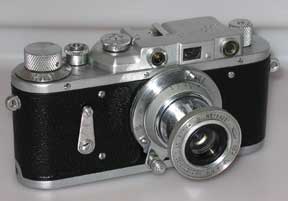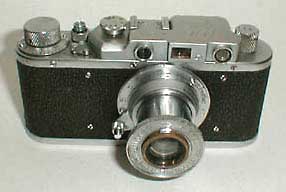
FED/ZORKI
1949
This
is the first KMZ-manufactured Leica copy with the Zorki name (as well
as FED). The initial version in 1948 had the FED name and the KMZ logo.
About 2,000 Fed/Zorkis were manufactured in 1948 and 1949.
This 1B was made in 1951. The name is engraved, not stamped. This camera, however, has the coarser body covering seen on the 1D and 1E models. This is one of the later "B" models. My other "B" models and My "Zorki Zorki" 1C export model have the smoother "pebble" style body covering. This camera does not appear to have been modified after leaving the factory so the different texture is intriguing. Most Zorki 1s appear to have come with a yellow accessory filter but most have been lost. The filter clips over the outside edge of the Industar-22 lens because there are no threads for a screw-on filter.
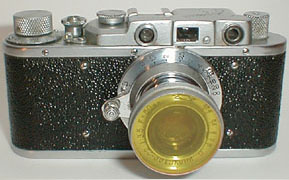
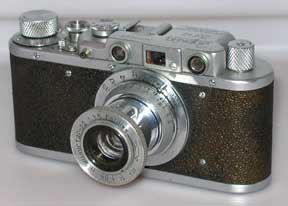
This 1B "Zorki Zorki", made in 1951 has an exceptional finish and operates more like a Leica or Canon of the same period. It also is unusual because it has a connector for a flash unit (on front under shutter speed dial). The flash synch was not standard and was apparently installed later--although the installation looks like it could have been done at the factory. This camera has a leather case lined with very soft green leather. The camera is rather delicate, however because it has the "soft body." It is easy to dent the early bodies by simply applying pressure with your thumbs. Beginning with the 1C the body was made from a stronger alloy.
This is an unusual camera--a combination of an early and late Zorki 1. The top has a four-digit serial number. The accessory shoe has indents in the ears like the very early Zorki 1s. It also has the FED type shutter button featured on the early Zorkis. But everything below the top is from a Zorki 1E or later (the bottom of the shutter crate has the look of a Zorki "C". This is a classic Heinz 57--a collection of parts from several cameras to make one working model. The fact that all these parts from different models work together demonstrates there weren't many huge changes in the Zorki 1 design during its eight-year run. I've taken it one step farther by replacing the vulcanite covering with pig skin.
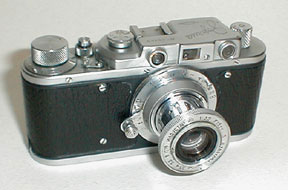
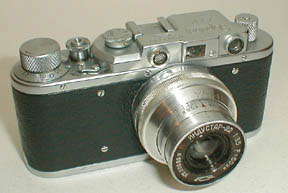
This is a relatively early "Zorki Zorki" 1C with the name on top of the viewfinder housing in both Cyrillic and Latin. The camera came equipped with the relatively scarce Industar 22 rigid lens. The rigid I-22 was only produced for a short time in the early 1950s. It is more complicated than the later I-50 rigid lens which is probably why it had a short life. Its finish also is better than the rigid I-50. This lens was probably original on this camera because the leather case was made to accommodate its greater depth. The body was manufactured in 1952.
The 1C is the first model with a black accent stripe around the top and bottom of the body. The body covering has a finer grained pattern than later models. There are only two screws in the back of the top instead of the three used in earlier models. There is no longer a film guide on the baseplate.This camera is a 1952 model. The lens is from a later camera. The Zorki Zorki model of the 1C was made for export. "Made in USSSR" is also engraved on top.
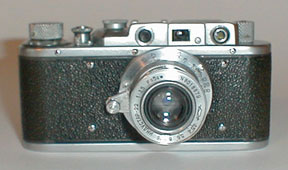
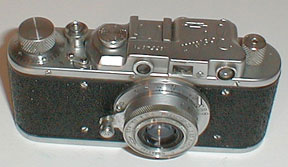
This Zorki 1C was built in 1953. It is definately a 1C because the serial number and lettering are still engraved on the top of the finder housing and the shutter crate is consistent with the 1C, with the long flat spring on the bottom. This camera does have the rougher textured body covering instead of the pebble finish found on most earlier 1Cs and 1Bs. It might be considered a transition model.
This Zorki 1D and a slightly different shutter mechanism than the camera above and the name is stamped rather than engraved on the viewfinder. The serial number has been moved from the top to the back of the viewfinder. It has a coarser body covering than the 1B and 1C. The early 1Ds don't have the black accent stripe around the lens mount. This camera was made in 1954 and would have to be considered a transition model.
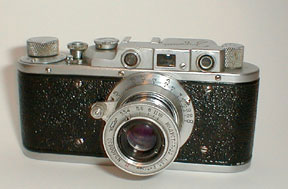
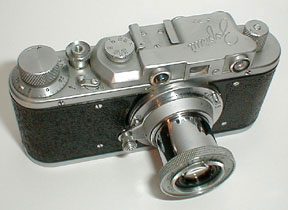
This is a Zorki 1D in final form with serial number on the back and an accent stripe around the lens mount. It also was made in 1954. The 1Ds seem to have a louder shutter than the earlier Zorki 1s. Some collectors consider the 1Ds the most reliable and robust of the Zorki 1 models.
ZORKI 1E
The main difference
between the Zorki 1E and 1D is the shutter speeds which are a more conventional
B, 25, 50, 100, 250 and 500. The older cameras had two more shutter speeds
including a 200 instead of 250. This camera's serial number begins with
"55" but is a seven digit number so it is likely it was made
in late 1954. This lens sports a slip-on yellow filter
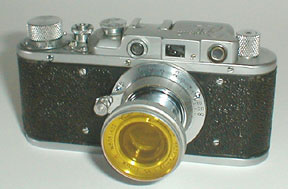
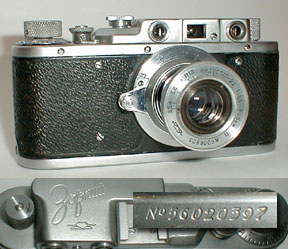
ZORKI
1E (last year)
This Zorki 1E was manufactured in 1956, the last year the model was
produced. Only 34,377 were made that year, compared to 204,000 in 1955.
1956 models are relatively scarce. No changes from 1955 8-digit model.
The Zorki 2 isthe last of the true KMZ Leica copies. It boasts a self-timer and a different shutter speed dial that seems to be more quiet than the earlier cameras. It also has lugs on the body to attach a strap so the camera can be carried without its heavy leather, "neverready" case.The Zorki 2 was only manufactured from 1954 to 1956. Only 10,310 were made. Today they are scarce. The Zorki 2 shutter speeds can allegedly be set without first cocking the shutter. It's probably best to wind the camera before changing shutter speeds, just to be on the safe side. In my estimation the strap lugs are a more valuable addition than the self timer.
